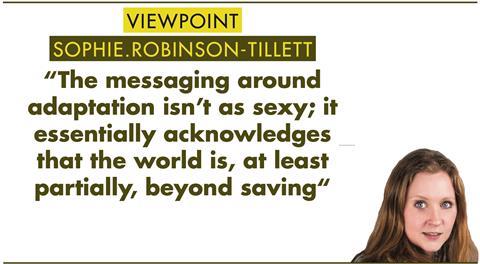In the middle of the now-famous speech that ended Stuart Kirk’s tenure as HSBC’s head of responsible investment, he said something that got lost. While most of Kirk’s controversial May presentation on ‘why investors need not worry about climate risk’ was picked apart on social media and in the press – resulting in his suspension and exit from the asset manager – his slide on climate adaptation (or ‘adaption’) was largely ignored.

Which is a shame, because it was arguably the most important, and credible, part of the speech. And with wildfires and droughts continuing across Europe, it needs talking about.
“One of the tragedies of this whole debate…. is that we spend way too much on mitigation financing and not enough on adaption financing,” Kirk said, adding that HSBC would “obsess” about the former, which relates to investments that help the economy decarbonise. Adaptation, on the other hand – investments to help society cope with the impacts of climate change – is “cheap and effective” but totally neglected by the private sector, Kirk argued.
And he’s not the only one with such views. The chair of both the UK’s Green Finance Institute and its Environment Agency, Emma Howard Boyd, warned earlier this year that global investors’ fixation on net zero was “robbing climate-resilient Peter to pay net-zero Paul”.
Fifty years ago, disasters related to weather, climate and water occurred roughly once a month across the Americas, according to the World Meteorological Organization. Now it’s weekly.
In Europe, the cost of this summer’s heat waves is still being counted. Trade bodies in Italy blamed the droughts for a 30% decrease in agricultural productivity, while the French government has promised to spend €850m on new fire-fighting planes and €1bn on planting trees. Months of wildfires and floods across the continent have further damaged a tourist industry that had barely recovered from the pandemic.
But despite the clear economic need to bolster climate resilience, research by the Climate Policy Initiative in 2021 found that just 7% of all climate investment had gone into adaptation projects. This is in part because the narrative is less compelling. When investors market their climate mitigation credentials, they trumpet their efforts to save the world. The messaging around adaptation isn’t as sexy; it essentially acknowledges the world is, at least partially, beyond saving.
But the problem is about more than just marketing. The sustainable-finance industry has been built around developed-markets listed equities. Over the past few years it has begun to cascade into neighbouring asset classes such as corporate bonds and private equity, but to conquer climate adaptation, it needs to make traction in project finance, infrastructure and emerging markets.
That requires buy-in from a new set of investment teams, regulators and companies. And unlike much of the current activity around climate mitigation – which focuses on stewardship, disclosure and creating financial products – investment into climate adaptation will require deals to look different.
Climate adaptation will rise up everyone’s agenda as the impacts of climate change become more dramatic, and investors will need to show they can support these efforts to become more resilient.
Sophie Robinson-Tillett, Contributing Editor, ESG
sophie.robinson-tillett@ipe.com









































No comments yet